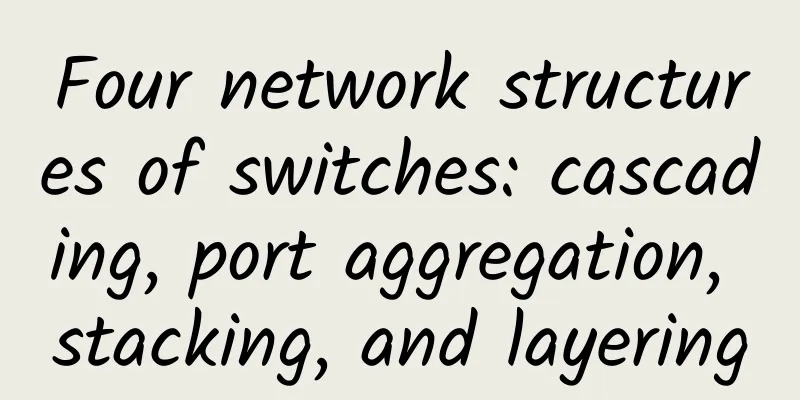Four network structures of switches: cascading, port aggregation, stacking, and layering

|
With the arrival of 5G and the new Internet of Things, higher requirements will be placed on switches, and the demand will increase. The Internet of Everything is inseparable from network infrastructure equipment - switches. Switches play a vital role in networking in the Internet of Things.
Four network structures of switches: 1. Cascade mode This is the most commonly used networking method, which is connected through the cascade port (UpLink) on the switch. Cascading can be defined as two or more switches connected to each other in a certain way. Multiple switches can be cascaded in a variety of ways according to needs. In a larger local area network such as a campus network, multiple switches generally form a bus, tree or star cascade structure according to performance and purpose. It should be noted that switches cannot be cascaded without limit. If more than a certain number of switches are cascaded, it will eventually cause a broadcast storm, resulting in a serious degradation of network performance. Structure diagram: 2. Port aggregation mode Port aggregation bundles multiple physical links between two devices into one logical link, thereby doubling the bandwidth (the bandwidth of this logical link is equivalent to the sum of the bandwidths of the physical links). In addition to increasing bandwidth, port aggregation can also evenly distribute traffic on multiple links, playing a role in load sharing; when one or more links fail, as long as there are links that are normal, the traffic will be transferred to other links. The entire process is completed within a few milliseconds, thus playing a redundancy role and enhancing the stability and security of the network. Structure diagram: 3. Stacking method Stacking refers to combining more than one switch to work together to provide as many ports as possible within a limited space. Multiple switches are stacked to form a stack unit. The performance index of stackable switches includes a parameter called "maximum stackable number", which refers to the maximum number of switches that can be stacked in a stack unit and represents the maximum port density that can be provided in a stack unit. Generally speaking, switches from different manufacturers and models can be cascaded with each other, but stacking is different. It must be performed between stackable switches of the same type (at least switches from the same manufacturer). Cascading is just a simple connection between switches, while stacking uses the entire stacking unit as a switch, which not only means an increase in port density, but also an increase in system bandwidth. Stacking can greatly improve the port density and performance of switches. Stacking units have port density and performance comparable to large rack-mounted switches, but the investment is much cheaper than rack-mounted switches and the implementation is much more flexible. This is the advantage of stacking. Rack-mounted switches can be said to be the product of stacking development to a higher stage. Rack-mounted switches are generally switches above the department level. They have multiple slots, high port density, support for multiple network types, good scalability, and strong processing capabilities, but they are expensive. Structure diagram: 4. Layering This method is generally used in more complex switch structures, which can be divided into access layer, aggregation layer and core layer according to their functions. This three-layer network architecture adopts a hierarchical model design, dividing the complex network design into several levels, with each level focusing on certain specific functions, so that a complex big problem can be turned into many simple small problems. Structure diagram: With the development of local area networks and metropolitan area networks, the above four methods will be more and more widely used. Today's sharing ends here. Do you understand? |
>>: Six good habits and 23 lessons that Linux operation and maintenance must know to avoid pitfalls!
Recommend
5G commercialization process accelerates operators to promote network intelligent transformation
The new round of technological changes continues ...
Brief discussion: What is cloud network?
The future of cloud is bright. By 2024, more than...
Huawei launches three new CloudLink collaboration products for enterprise communications, turning conference rooms into "war rooms"
[51CTO.com original article] Recently, Huawei lau...
Home Networking Guide - How to Create WiFi Throughout Your Home During the Renovation Season
September and October are the golden months. Now ...
Yecao Cloud Labor Day Promotion: Hong Kong BGP line VPS special price from 88 yuan per year, Hong Kong dedicated server from 199 yuan/month
Yecaoyun has already started the Labor Day promot...
HostYun: Los Angeles CN2 GIA line AMD series restock, native IP monthly payment starts from 22 yuan
HostYun is a domestic hosting company (formerly k...
How to solve the problem that Ubuntu 18.04 cannot start normally after switching from XEN to KVM
There are fewer and fewer businesses that still u...
Taking stock of Internet companies that have deployed blockchain: Is blockchain a "panacea" or a "scam"?
Bitcoin was launched in 2009. As the price of Bit...
Six advantages of single-pair Ethernet technology
As Single Pair Ethernet (SPE) gains more and more...
5G standardization work encounters obstacles, and the launch of standards may be delayed
The high-speed 3GPP 5G standard work may encounte...
The persistence behind comprehensive, stable and high-quality CDN: integration + self-built
On November 16, 2016, GFIC2016, hosted by DVBCN&a...
5G and manufacturing advantages: optimism tempered
5G-enabled factories will have the ability to mai...
The Winter Olympics is about to open, and the on-site communication network technology is deeply revealed!
In 11 days, the world-renowned Beijing Winter Oly...
Highlights | Speech content of the 39th GTI seminar (2/2)
Previous: Highlights | Contents of the 39th GTI S...
UFOVPS limited 30% off, Japan/Hong Kong CN2 GIA/US high-defense VPS monthly payment starts from 26 yuan, top up 200 yuan and get 20 yuan
UFOVPS has launched a promotional event during th...









